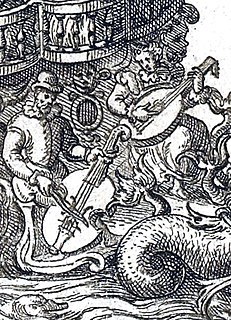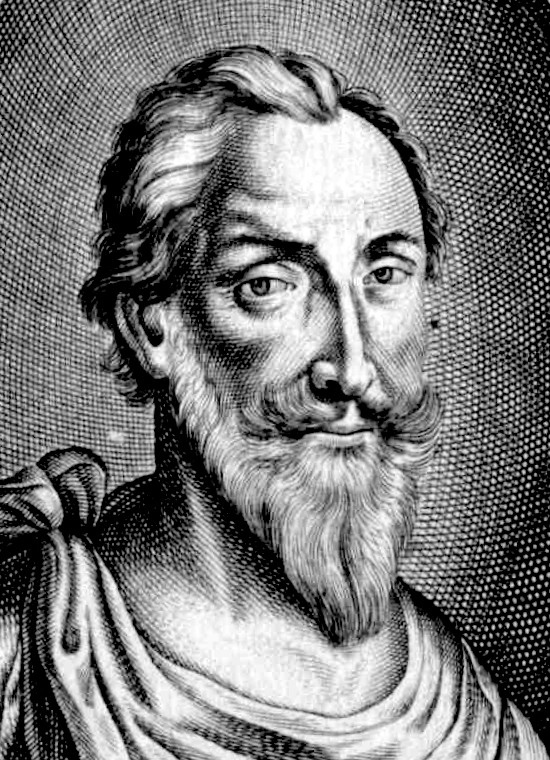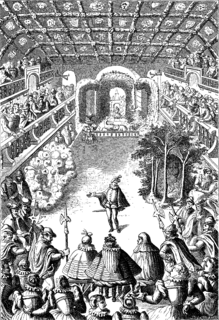
Girard de Beaulieu, better known by the incorrectly recorded name Lambert de Beaulieu (? – after 1587) was a French bass singer, instrumentalist, and composer. [2] He was employed at the court of Henri III as basse singer and composer from 1559. He was associated with the Académie de Baïf, one of whose aristocratic poets, Nicolas Filleul de La Chesnaye, the king's almoner, was to provide the lyrics for the ballet Circé in the first French ballet de cour , the Balet Comique de la Royne of 1581, for which Beaulieu and Jacques Salmon provided the music. Choreography and overall direction were provided by the Italian dancing master Baltazarini, known as Balthasar de Beaujoyeulx. Sets and costumes were provided by Jacques Patin.
A bass ( BAYSS) is a type of classical male singing voice and has the lowest vocal range of all voice types. According to The New Grove Dictionary of Opera, a bass is typically classified as having a vocal range extending from around the second E below middle C to the E above middle C (i.e., E2–E4). Its tessitura, or comfortable range, is normally defined by the outermost lines of the bass clef. Categories of bass voices vary according to national style and classification system. Italians favour subdividing basses into the basso cantante (singing bass), basso buffo ("funny" bass), or the dramatic basso profondo (low bass). The American system identifies the bass-baritone, comic bass, lyric bass, and dramatic bass. The German fach system offers further distinctions: Spielbass (Bassbuffo), Schwerer Spielbass (Schwerer Bassbuffo), Charakterbass (Bassbariton), and Seriöser Bass. These classification systems can overlap. Rare is the performer who embodies a single fach without also touching repertoire from another category.
Nicolas Filleul de La Chesnaye was a French poet. He was professor at the College of Harcourt, Eure where in 1563, he produced Achille (1563). His texts were used for the Ballet Comique de la Reine in 1581.

An almoner is a chaplain or church officer who originally was in charge of distributing money to the deserving poor. The title almoner has to some extent fallen out of use in English, but its equivalents in other languages are often used for many pastoral functions exercised by chaplains or pastors. The word derives from the Ancient Greek: ἐλεημοσύνη eleēmosynē (alms), via the popular Latin almosinarius.
Contents
Beaulieu's wife was the Genoese soprano and lutenist Violante Doria. [3] They had a daughter Claude de Beaulieu who later was paid as a lutenist at the court.

Violante Doria, also known as Yolande or Yolante, was an Italian soprano from Genoa. She was considered to be one of “the most successful musicians in France during the reigns of the last Valois kings.” She was married to bass singer Girard de Beaulieu who was a well-known and important singer of the royal court from as early as 1572 until the last year of his life in 1590.” The couple played a large role in the creation of the French ballet de cour, the Balet comique de la royne, in 1581. The successful careers of both Doria and her husband were an important part of structuring the music of the royal court and show the significance in the rise of chamber music.
The original documents of 1581 indicate the composer only as "Sieur de Beaulieu". The error concerning his name, and consequent separation of the bass singer and composer into two biographies, is due to an erroneous "Lambert de Beaulieu" in a letter by Rudolf II, Holy Roman Emperor to the French king attempting to employ the composer Beaulieu for his own court. The error in Rudolf's letter was reproduced by François-Joseph Fétis in his influential Biographie universelle des musiciens. [4]

Rudolf II was Holy Roman Emperor (1576–1612), King of Hungary and Croatia, King of Bohemia (1575–1608/1611) and Archduke of Austria (1576–1608). He was a member of the House of Habsburg.

François-Joseph Fétis was a Belgian musicologist, composer, teacher, and one of the most influential music critics of the 19th century. His enormous compilation of biographical data in the Biographie universelle des musiciens remains an important source of information today.





